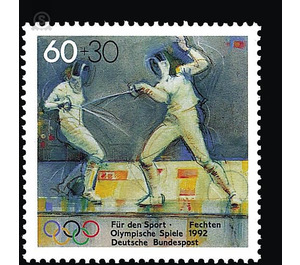sport aid - Germany / Federal Republic of Germany 1992 - 60 Pfennig
Theme: Post & Philately
| Country | Germany / Federal Republic of Germany |
| Issue Date | 1992 |
| Face Value | 60.00 |
| Color | multi-colored green |
| Perforation | K 13 3/4 |
| Printing Type | Multicolor offset printing |
| Stamp Type | Postage stamp |
| Item Type | Stamp |
| Chronological Issue Number | 1465 |
| Chronological Chapter | GER-BRD |
| SID | 983593 |
| In 36 Wishlists | |
Fencing is a sporty duel with foil and sword for men and women and in addition with the saber for men. The foil is a pure thrust weapon; The name comes from the Italian word "fioretta", small flower or bud, and means the bud-like button that was put on the tip of the weapon during fencing exercises. Fighting is done with electronic scoring on a non-conductive mat of copper braid. The jacket of the fencer of brocade fabric limits the valid target area from the top of the collar to the groin and on the back to the waistline. The evaluation takes place according to the rules of the World Federation (F.I.E.). Simplified, it can be said that only the hits of the fencer who has the right to attack in the combat situation are scored. The right of attack begins with the extended arm and the forward movement. The goal of the fencer is thus to attach valid hits without being hit yourself. Prerequisite for this is the mastery of the weapon and the parade and leg technique. The weapon is guided with thumb and forefinger and held with the other fingers. The combat position is chosen so that it offers the opponent the smallest hit area and allows the fencer fast forward and backward movements. German fencers have been taking on an excellent international position for many years, not only because of their successes at World Championships, but especially at the Olympic Games. Among the best-known foil fighters in the individual are Helene Meyer (gold medal 1924, silver medal 1936), Erwin Casmir (1936 silver), Heidi Schmid (1960 gold), Cornelia Hanisch (1984 silver in singles and gold with the team, quadruple world champion) and Matthias Behr (1984 silver). The three fencers Anja Fichtel, Sabine Bau and Zita Funkenhauser succeeded in 1988 in Seoul when they won not only all three individual medals but also the gold medal in the team together with Christiane Weber and Annette Klug.


